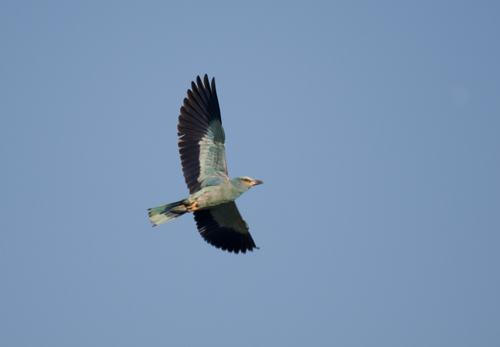European Roller
Study species: European Roller
Research topic: Full annual cycle
Project organiser:
Status: Active
Current scientific research has shown conclusively that the total number of migratory birds globally has declined significantly in recent years as a direct result of human interference (Sanderson et al 2006; Vickery et al 2013). The charismatic European Roller Coracias garrulus is one such bird that migrates annually between Eurasia and Africa, and whose numbers are known to be in decline. Until recently this species was classified as globally Near Threatened by the IUCN and Birdlife International, and because of its vulnerable conservation status, an International Species Action Plan for the European Roller was drawn up by Birdlife International in 2008 in an effort to ensure its conservation on its northern breeding grounds (see Kovacs et al 2008).
The main threats to this species across Europe include the loss of suitable breeding habitat and nest sites due to agricultural practices, as well as the use of pesticides which kills their invertebrate prey and reduces food availability (Fry et al 1992; Kirby et al 2008). Many of these threats are likely to be exacerbated by climate change (Simmons et al 2004; UNEP/CMS 2014). Numerous birds also fall prey to indiscriminate and illegal hunting along their migration routes, particularly in the Mediterranean region, as well as illegal trapping for the pet trade (BirdLife International 2013; Kirby et al 2008).
There is an active, dedicated network of researchers and conservation organisations working together across the species’ breeding range in Europe and Asia in an attempt to find realistic conservation solutions (Kovacs et al 2008). As well as tracking population trends over time, other focus areas include installing nest boxes in appropriate habitats, monitoring breeding success, researching ecological needs, and trying to encourage the use of non-toxic pesticides and more sustainable farming practices (Kovacs et al 2008). Information from satellite tracking devices as well as geologgers and ringing recoveries are being used to better understand the migratory routes and stop-over sites used by these birds annually (Finch et al 2015).

Thanks to such concerted conservation efforts, the European Roller was subsequently downlisted in 2015 from Near Threatened to Least Concern thanks to converted conservation actions in several countries which have played an important role in contributing to national recoveries. The most recent assessment of the European population suggests that it is declining at a less severe rate than in previous years, and the Central Asian population is currently not thought to be declining significantly.
However, the global population is still thought to be in decline, and in need of continued monitoring and ongoing conservation interventions (Kovacs et al 2008). Also, the European Roller can act as a very appropriate ‘indicator species’ for critical site networks on a landscape level (UNEP/CMS 2014), and as a ‘flagship species’ regarding the status of other Palearctic migrants which share similar habitats (Sanderson et al 2006). These could include species such as European Bee-eater; European Nightjar; Common Cuckoo; Steppe Buzzard; Black Kite; Montague’s Harrier; Pallid Harrier; Amur Falcon; Red-footed Falcon; Lesser Kestrel; Red-backed Shrike; Lesser Grey Shrike; Sand Martin and Barn Swallow.
There are two subspecies of the European Roller. The nominate Coracias garrulus garrulus breeds from Morocco, south-west and south-central Europe and Asia Minor east to south-west Russia. C. g. semenowi breeds in Iraq and Iran, Kashmir and Turkmenistan and into north-west China. The birds overwinter in two distinct regions of Africa: via the Western Flyway from Senegal east to Cameroon, and via the Eastern Flyway from Ethiopia to Angola and South Africa, most abundantly in coastal lowalnds from south Somalia to Tanzania, and in a broad belt from coastal Angola through northeast Namibia and Botswana to Zimbabwe and south Mozambique (Fry et al 1992).

Establishment of an African monitoring group on the wintering grounds
While there is a very strong knowledge base and effective conservation action on the breeding grounds, very little is known about these birds on their African wintering grounds. The population status and trends remain unknown, the threats faced by these birds on both their migration routes and wintering grounds are unclear, and many gaps still exist in understanding the flyway routes followed by different population and subspecies (Kirby et al 2008). In order to effectively conserve migratory birds, it is vital to understand their entire migratory route and stop-over sites, as conserving them in one area of their range would obviously lack value if they were being negatively impacted on in another (Beresford et al 2010; Kirby et al 2008).
The aim of our programme is to help fill in some of the vital missing pieces in the European Roller migration puzzle by setting up a long-term monitoring programme in Africa. This will help to improve our understanding of the status of European Rollers on their wintering grounds, and through collaboration with relevant local and international organisations, contribute towards developing appropriate strategies to aid the conservation of the species. Our main objectives would be to:
- Clarify current population status of European Rollers in the various African range states and monitor long-term population trends
- Draw up a continental Species Action Plan for the European Roller on the African wintering grounds to complement Kovacs et al.
- Identify, rank and hopefully help mitigate potential threats to the species along the migration routes and on the wintering grounds
- Track the movements of European Rollers using satellite telemetry in order to fully understand their complete annual life cycle between breeding and wintering grounds.
- Work with and establish an African network of conservation organisations and promote conservation ‘champions’ for European roller conservation.
- Concurrently promote the monitoring and conservation of bird migration in general.
- Focus on monitoring within the relevant Important Bird Areas networks in the respective range states.
- Collaborate with relevant local and international organisations
By Helene and Rael Loon (October 2016)
References
Beresford et al (2010) Poor overlap between the distribution of Protected Areas and globally threatened birds in Africa. Animal Conservation 14:99-107.
BirdLife International (2013) State of Africa’s birds 2013: Outlook for our changing environment. Nairobi, Kenya: BirdLife International Africa Partnership.
Finch et al (2015) A pan-European, multipopulation assessment of migratory connectivity in a near-threatened migrant bird. Diversity and Distributions 1-12
Fry, C.H., Fry, K. & Harris, A. (1992) Kingfishers, Bee-eaters & Rollers. Russel Friedman Books, South Africa.
Kirby et al (2014) Key conservation issues for migratory land-and-waterbird species on the world’s major flyways. Bird Conservation International. 18:49-73.
Kovacs A., Barov B., Orhun C., Gallo-Orsi U. (2008) International Species Action Plan for the European Roller Coracias garrulus garrulous. BirdLife International.
Sanderson, F.J., Donald, P.F., Pain, D.J., Burfield, I.J. and Van Bommel, F.P., 2006. Long-term population declines in Afro-Palearctic migrant birds. Biological conservation, 131(1), pp.93-105.
Simmons, R.E., Barnard, P., Dean, W.R.J., Midgley, G.F., Thuiller, W. and Hughes, G., 2004. Climate change and birds: perspectives and prospects from southern Africa. Ostrich-Journal of African Ornithology, 75(4), pp.295-308.
UNEP/CMS (2014) A Review of Migratory Bird Flyways and Priorities for Management. CMS Technical Series No.27, Bonn, Germany
Vickery et al (2013) The decline of Afro-Palaearctic migrants and an assessment of potential causes. Ibis. 156:1-22
